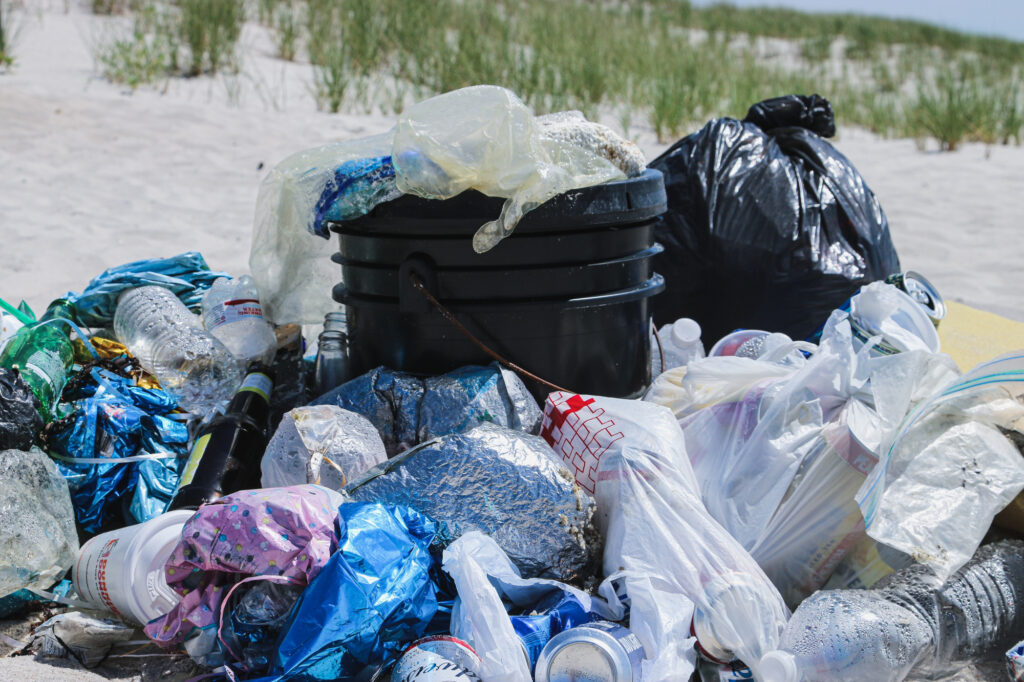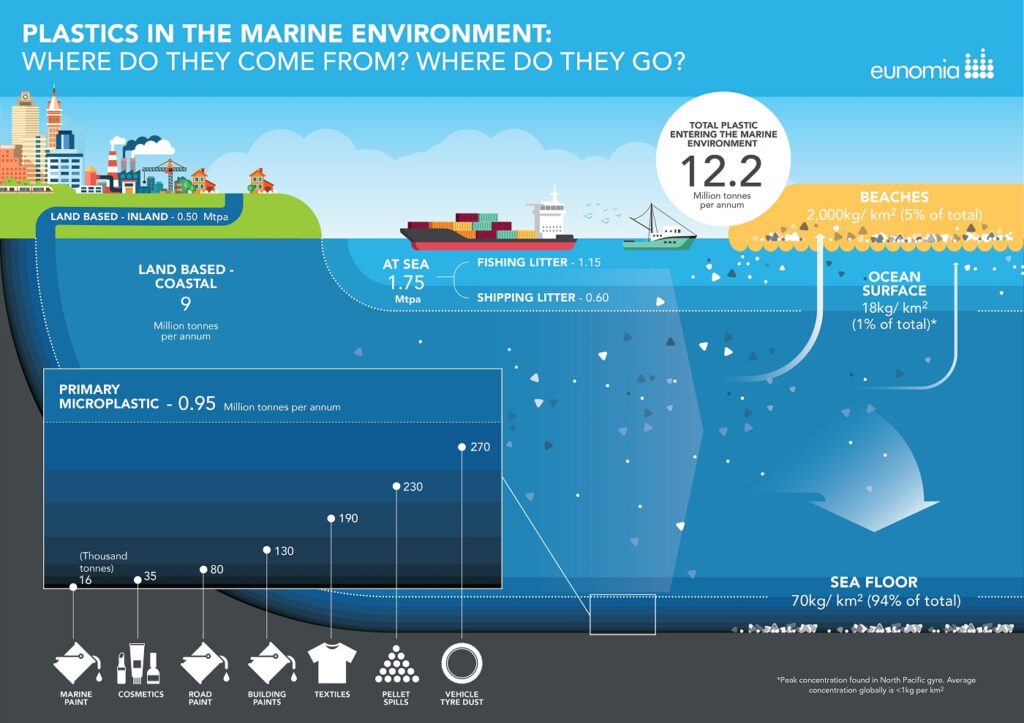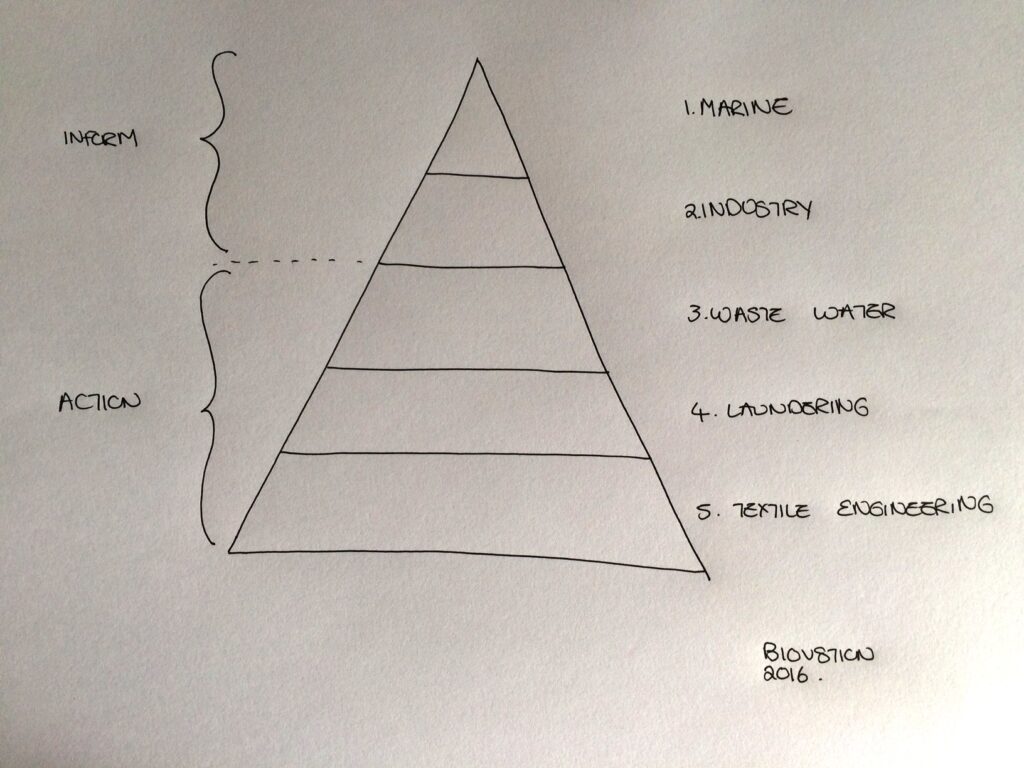
Co-written with: Sophie Mather, biov8tion.
This article appeared in edited format in Ecotextile News, December/January 2016/7 edition.
Important Note:
This article was written in late 2016. Science has moved on considerably since. The insights stated here may therefore no longer be fully valid. For the latest knowledge and science-base around microfibres in textiles, please visit The Microfibre Consortium‘s website.
Introduction
The effect of plastics in our oceans has been repeatedly hit in the news over the last few years. The stats are indeed sobering: There will be one ton of plastic for every three tons of fish in our oceans by 2025, and by 2050 the total mass (by weight) of plastic in our oceans will overtake that of fish (Source). To this extent, two sportswear industry giants, Nike and Adidas, could not ignore the tide and have each launched products that promote ‘turning waste into something cool’. Both address the larger marine pollution challenge rather than the microfiber scale which this the focus of this article. (Source)
Why does this matter for the textile industry?
Environmental plastic pollution does not biodegrade, it fragments into smaller pieces usually not visible to the naked eye. A hazard in two forms: as a plastic in totality; or as a microfiber/micro particle, which also carries chemistry (pollution) into the environment, from the product they started life as. Research to date shows that this pollution cannot be exhaustively blocked through wastewater treatment plants, consequently micro particles are ending up in our global waterways.
It is a fact that over 60% of the world textile production is made from synthetic fibres such as Polyester, Nylon or Acrylic, i.e. ‘plastic’. Fragmentation occurs once broken apart from its garment during manufacture or at the consumer wash and wear phase. As such, research shows that the textile sector is a substantial contributor, with extrapolated figures demonstrating this could be as high as 20% of all primary industry micro plastics:
- 2011 – Early research highlights that microfibers make up 85% of human-made debris around global shorelines (Source);
- 2015 – Data shows that microfibers are the 2nd most common type of debris in the Lake of Michigan (Source),
- 2016 – Recent tangible evidence shows a single fleece jacket can shed as many as 250,000 synthetic fibres per laundering, significantly more than the 1,900 fibres recorded in the 2011 Browne report.
The effect of micro plastics in our oceans
I’ll eat my hat! This English term of amazement rings very true when referring to the effects of microfibers on the marine life. Ingested as a primary food source (e.g. plankton, lugworm) and then subsequently fed through the marine food chain, means that ultimately the seafood we eat, may contain elements of micro plastics.
The data on human impact is currently sparse, yet some shocking statistics demonstrating the need for more factual knowledge:
- 90 micro plastic particles per 250gm portion of muscles
- 11,000 micro plastic particles per annum, from an annual shellfish dietary intake. (European consumer). (Source)
- More data exists at the environmental level giving for a very sobering reading.
- At least 8 million tonnes of plastic enter our oceans annually. (Source)
- 90% of birds have plastic debris in their stomachs (Source).
- Micro plastics / micro fibres have potential to carry hazardous substances. (E.g. PBDEs, other brominated flame retardants, nonylphenol, bisphenol A (BPA), plasticizers and added biocides). (Source)
- Young fish may prefer tiny plastic particles to natural food sources, effectively starving them before they reproduce. (Source)
Campaigns and policy: Efforts and players
There is currently no policy that pertains to textile micro fibre pollution. And neither has the industry to date been hit by large NGO campaigns, although this is a question of ‘when’ rather than ‘if’. The industry requires deeper and industry specific data on which to build campaigns, products and – ultimately – policy. Data will either come from the NGO’s internally, or ideally direct from the industry, which has the ability to proactively act on this, ahead of having no choice to.
Different players working with this topic can roughly be grouped as follows:
- Grassroots researchers: Either Academia or the research arm of campaign organisations. This area forms the largest body of knowledge to date.
- Campaign NGOs: Offer attractive grassroots information to a wider public.
- Governments: Policy makers and legislators work from insights gained by academia and researcher. Discussion at the policy level are currently caught up exclusively in micro beads which gives the textiles industry an insight into the direction that will need to be taken.
- Businesses: Working to obtain accurate information on which to build business strategy, as it pertains to their specific sphere of activity.
- Service Providers: Support any one of the above players, as a result of the urgent need for accurate and valid information.
The most recent campaign work from September 2016, is that of Parley for the Ocean and the Plastic Soup Foundation, which together have created a global multi-stakeholder alliance to tackle the issue of micro fibres. The related campaign is supported by over 100 NGOs including Greenpeace UK and Austria. In addition, running along side, is the Rozalia Project as well as Guppyfriend, who offer the end consumer a quick fixe to this problem via laundry ‘nets’ that catch microfiber in the domestic washing machine. (Source; Source)
Textile Industry: Known and unknowns in micro fibres
The Known?
Recent shocking stats, cf. Figure 1, reveal that textiles micro fibres contribute an estimated 190 million tonnes per annum of primary micro plastics within our oceans.9 In comparison, at just 35 million tonnes, the cosmetics industry has already taken action through policy, banning micro beads in the US, Canada and among key global cosmetics brands.
The challenges faced by the textile industry may not be as easy as the natural substitutions implemented in cosmetics, but knowing that governments are already supporting this change across other industry sectors, gives welcome support to finding textile solutions.

Calculations were based on an extrapolation from Browne’s 2011 work1, and scaled up using European figures for average washes per household. This work is not exhaustive, but is currently the best-informed data.
Ground-breaking insights with direct impact on the textile industry were highlighted in 2011 Browne paper. This work has formed the backbone of much of the textile direction to date. Since, existing work can be subdivided into 5 key areas, with most insights biased to only few.
1. Marine: A breadth of insights has enabled the textile industry to see their impact at the marine level, and the rational behind immediate action.
2. Industry: There are good estimates that outline the order of magnitude of the problem for which the textile industry is directly responsible (cf. Figure 1):
3. Waste water: Wastewater treatment centres seem the obvious place to ‘capture’ pollution, however work to date has been primarily around measurement of micro fibres.
4. Laundering: Apparel industry activity started at the laundering level, the logical place to investigate fibre shedding. Initial research (by Patagonia, in collabration with the Bren School) focused on fleece jackets with a newly devised wash protocol, in order that true like-for-like data could be compared. Results showed top loading washing machines shed roughly 430% more fibre mass than side loaders, and that aged jackets shed roughly 80% more fibre than new.
5. Textile engineering: Effecting change at the textile engineering level will be complex, yet vital as a preventive shedding measure. Although work in this area has been discussed, there are no concrete results as of yet, and cross industry support and collaboration is required to make progress.

The Unknowns?
Analysing this issue through the ‘5 tiers of knowledge and action’ (Figure 2), it becomes clear that current on-going work is prioritised ‘at the top’ to ‘inform’ (i.e., where the microfiber effects are captured, not prevented.)
Therefore, a mind shift is overdue, in order to switch the focus to foundational work, effect textile engineering and how the issue can be prevented.

Summary & Conclusion
With seasonally renewed reminders of the Greenpeace’s DETOX campaign and its effects, the urgent need for the industry to collaborate and find solutions pro-actively to this micro fibre challenge, is self-explanatory. The potential for further and deeper damage is evident.
In this article, the bigger picture of the micro plastics discussion has been outlined, as well as where the relevant challenges and opportunities are with regards to micro fibres particularly – the area of immediate relevance to the textile industry.
The question now is: What can the apparel supply chain do to tackle the unanswered questions? And how can we all work together to get timely and effective results?
Here a few pointers to this:
-
Data:
Data is king and the more granular the better.
It is imperative to move from extrapolated to actual measured data, to allow identification of the order of magnitude the textile industry is directly responsible. Secondary data is required at every stage of the textile process chain to identify where the issue is most prevalent. - Education and communication: With outputs that address solutions from existing technology, the development of robust textile engineering development guidelines should support brands, retailers and their supply chain partners in understanding how to best engineer textiles using existing processes and technologies.
- Textile engineering: With outputs that address solutions from currently undiscovered technology, total textile reengineering has potential longer term to mitigate this issue completely.
- Consumer: There is a need to move from knee jerk consumer use phase suggestions to learn in more detail about what the influencing factors are, and how we can include the consumer in doing ‘their share’ towards improving the situation without other knocks on sustainability impacts.
-
Legislation:
Legislation guarantees a level playing field for everyone.
Which aspects can be legislated for and which ones probably/rather not?
It goes without saying that there is one aspect we cannot do without: Our industry itself needs to make a move, away from general interest and conversation, towards delivering insights and measurable results.

